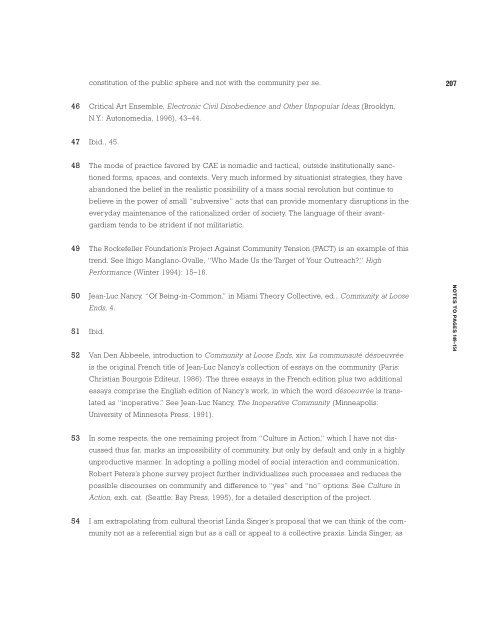ONE PLACE AFTER ANOTHER - Monoskop
ONE PLACE AFTER ANOTHER - Monoskop
ONE PLACE AFTER ANOTHER - Monoskop
Create successful ePaper yourself
Turn your PDF publications into a flip-book with our unique Google optimized e-Paper software.
constitution of the public sphere and not with the community per se.<br />
46 Critical Art Ensemble, Electronic Civil Disobedience and Other Unpopular Ideas (Brooklyn,<br />
N.Y.: Autonomedia, 1996), 43–44.<br />
47 Ibid., 45.<br />
48 The mode of practice favored by CAE is nomadic and tactical, outside institutionally sanctioned<br />
forms, spaces, and contexts. Very much informed by situationist strategies, they have<br />
abandoned the belief in the realistic possibility of a mass social revolution but continue to<br />
believe in the power of small “subversive” acts that can provide momentary disruptions in the<br />
everyday maintenance of the rationalized order of society. The language of their avantgardism<br />
tends to be strident if not militaristic.<br />
49 The Rockefeller Foundation’s Project Against Community Tension (PACT) is an example of this<br />
trend. See Iñigo Manglano-Ovalle, “Who Made Us the Target of Your Outreach?,” High<br />
Performance (Winter 1994): 15–16.<br />
50 Jean-Luc Nancy, “Of Being-in-Common,” in Miami Theory Collective, ed., Community at Loose<br />
Ends, 4.<br />
51 Ibid.<br />
52 Van Den Abbeele, introduction to Community at Loose Ends, xiv. La communauté désoeuvrée<br />
is the original French title of Jean-Luc Nancy’s collection of essays on the community (Paris:<br />
Christian Bourgois Editeur, 1986). The three essays in the French edition plus two additional<br />
essays comprise the English edition of Nancy’s work, in which the word désoeuvrée is trans-<br />
lated as “inoperative.” See Jean-Luc Nancy, The Inoperative Community (Minneapolis:<br />
University of Minnesota Press, 1991).<br />
53 In some respects, the one remaining project from “Culture in Action,” which I have not dis-<br />
cussed thus far, marks an impossibility of community, but only by default and only in a highly<br />
unproductive manner. In adopting a polling model of social interaction and communication,<br />
Robert Peters’s phone survey project further individualizes such processes and reduces the<br />
possible discourses on community and difference to “yes” and “no” options. See Culture in<br />
Action, exh. cat. (Seattle: Bay Press, 1995), for a detailed description of the project.<br />
54 I am extrapolating from cultural theorist Linda Singer’s proposal that we can think of the com-<br />
munity not as a referential sign but as a call or appeal to a collective praxis. Linda Singer, as<br />
207<br />
NOTES TO PAGES 149–154

















